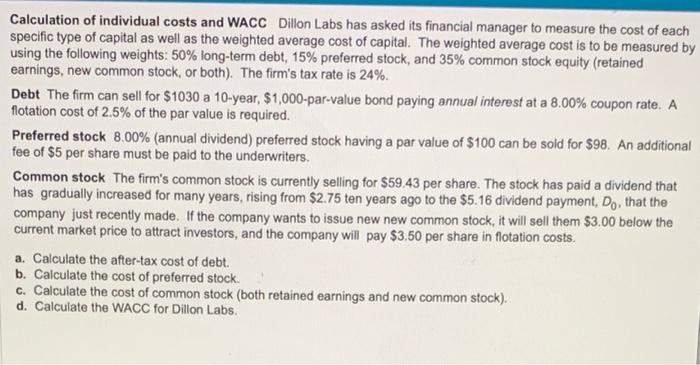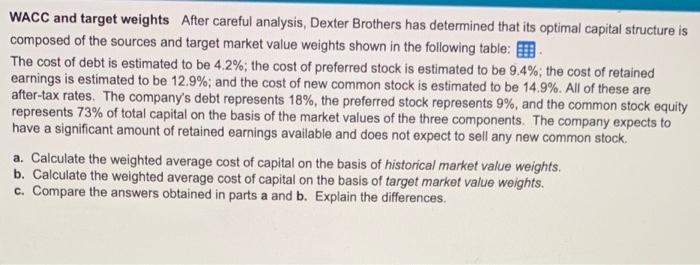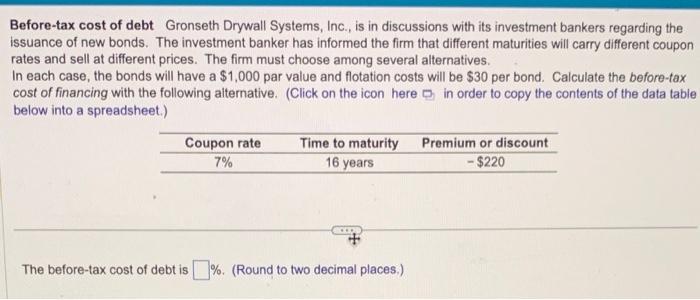Answered step by step
Verified Expert Solution
Question
1 Approved Answer
please respond within 1 hour!!! Calculation of individual costs and WACC Dillon Labs has asked its financial manager to measure the cost of each specific



please respond within 1 hour!!!
Calculation of individual costs and WACC Dillon Labs has asked its financial manager to measure the cost of each specific type of capital as well as the weighted average cost of capital. The weighted average cost is to be measured by using the following weights: 50% long-term debt, 15% preferred stock, and 35% common stock equity (retained earnings, new common stock, or both). The firm's tax rate is 24%. Debt The firm can sell for $1030 a 10-year, $1,000-par-value bond paying annual interest at a 8.00% coupon rate. A flotation cost of 2.5% of the par value is required. Preferred stock 8.00% (annual dividend) preferred stock having a par value of $100 can be sold for $98. An additional fee of $5 per share must be paid to the underwriters. Common stock The firm's common stock is currently selling for $59.43 per share. The stock has paid a dividend that has gradually increased for many years, rising from $2.75 ten years ago to the $5.16 dividend payment, D0, that the company just recently made. If the company wants to issue new new common stock, it will sell them $3.00 below the current market price to attract investors, and the company will pay $3.50 per share in flotation costs. a. Calculate the after-tax cost of debt. b. Calculate the cost of preferred stock. c. Calculate the cost of common stock (both retained earnings and new common stock). d. Calculate the WACC for Dillon Labs. WACC and target weights After careful analysis, Dexter Brothers has determined that its optimal capital structure is composed of the sources and target market value weights shown in the following table: The cost of debt is estimated to be 4.2%; the cost of preferred stock is estimated to be 9.4%; the cost of retained earnings is estimated to be 12.9%; and the cost of new common stock is estimated to be 14.9%. All of these are after-tax rates. The company's debt represents 18%, the preferred stock represents 9%, and the common stock equity represents 73% of total capital on the basis of the market values of the three components. The company expects to have a significant amount of retained earnings available and does not expect to sell any new common stock. a. Calculate the weighted average cost of capital on the basis of historical market value weights. b. Calculate the weighted average cost of capital on the basis of target market value weights. c. Compare the answers obtained in parts a and b. Explain the differences. Before-tax cost of debt Gronseth Drywall Systems, Inc., is in discussions with its investment bankers regarding the issuance of new bonds. The investment banker has informed the firm that different maturities will carry different coupon rates and sell at different prices. The firm must choose among several alternatives. In each case, the bonds will have a $1,000 par value and flotation costs will be $30 per bond. Calculate the before-tax cost of financing with the following alternative. (Click on the icon here below into a spreadsheet.) The before-tax cost of debt is \%. (Round to two decimal places.) Step by Step Solution
There are 3 Steps involved in it
Step: 1

Get Instant Access to Expert-Tailored Solutions
See step-by-step solutions with expert insights and AI powered tools for academic success
Step: 2

Step: 3

Ace Your Homework with AI
Get the answers you need in no time with our AI-driven, step-by-step assistance
Get Started


